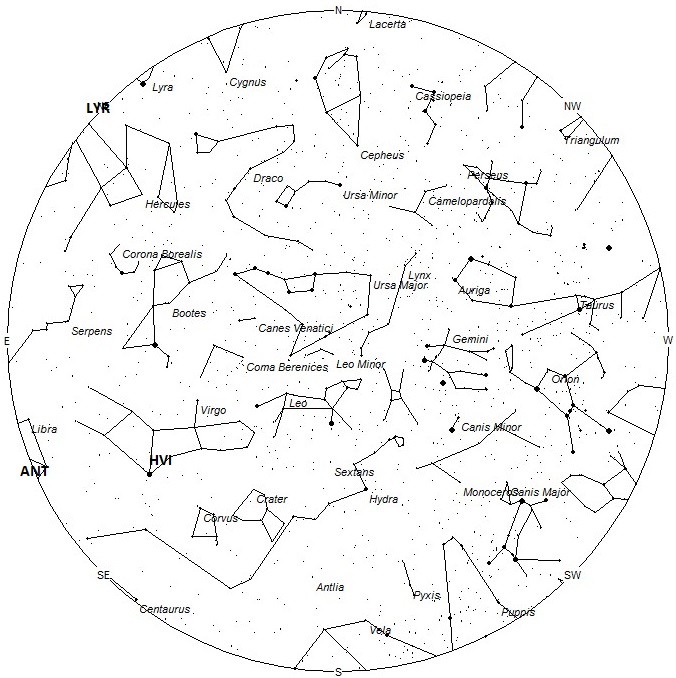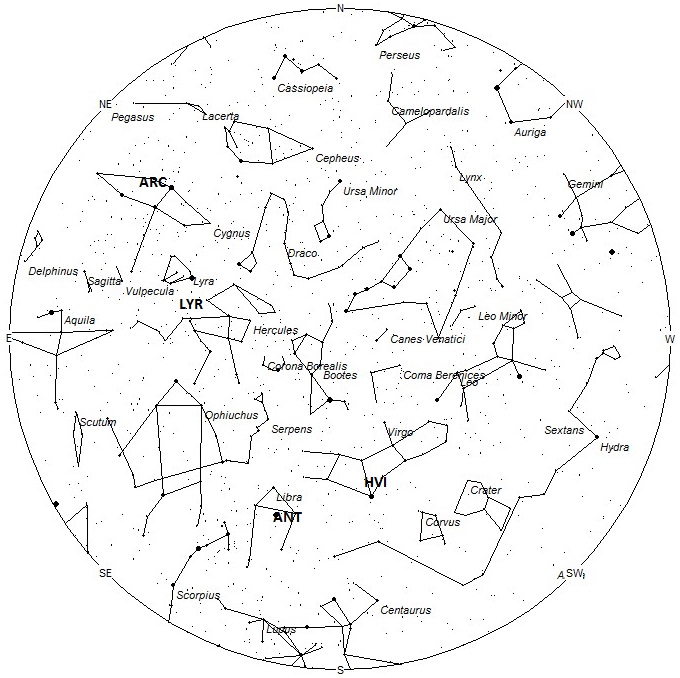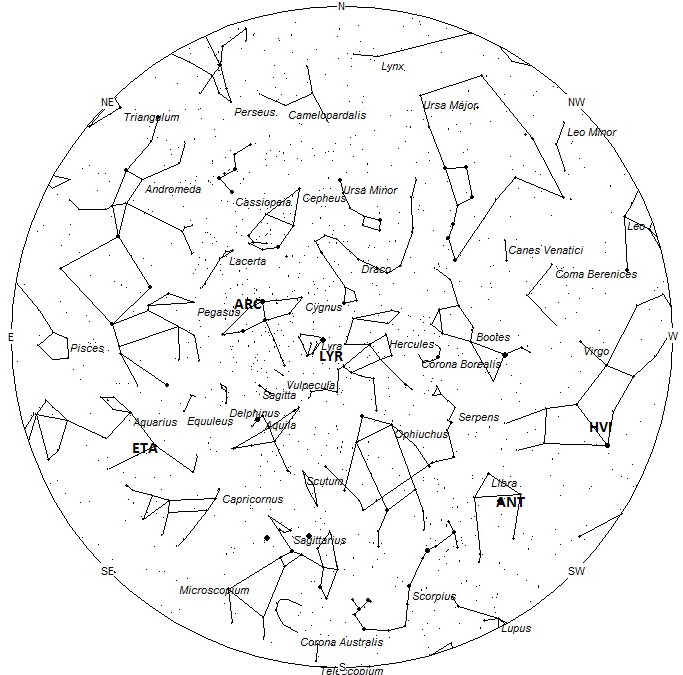
During this period the moon will reach it’s first quarter phase on Sunday April 22. At that time the moon will be located 90 degrees east of the sun and will set near 02:00 local daylight saving time (LDT) as seen from mid-northern latitudes. As the week progresses the waxing gibbous moon will seriously impede on meteor viewing as it sets later in the morning with each passing night. The estimated total hourly meteor rates for evening observers this week is 2 as seen from mid-northern latitude (45N) and 3 from the southern tropics (25S). For morning observers the estimated total hourly rates should be near 20 as seen from mid-northern latitudes (45N) and 13 from the southern tropics (25S). Evening rates are reduced due to moonlight. Note that the morning rates are enhanced by the Lyrid meteor shower this weekend. As the week progresses rates will fall substantially from the figures listed above. The actual rates will also depend on factors such as personal light and motion perception, local weather conditions, alertness and experience in watching meteor activity. Note that the hourly rates listed below are estimates as viewed from dark sky sites away from urban light sources. Observers viewing from urban areas will see less activity as only the brighter meteors will be visible from such locations.
The radiant (the area of the sky where meteors appear to shoot from) positions and rates listed below are exact for Saturday night/Sunday morning April 21/22 These positions do not change greatly day to day so the listed coordinates may be used during this entire period. Most star atlases (available at science stores and planetariums) will provide maps with grid lines of the celestial coordinates so that you may find out exactly where these positions are located in the sky. A planisphere or computer planetarium program is also useful in showing the sky at any time of night on any date of the year. Activity from each radiant is best seen when it is positioned highest in the sky, either due north or south along the meridian, depending on your latitude. It must be remembered that meteor activity is rarely seen at the radiant position. Rather they shoot outwards from the radiant so it is best to center your field of view so that the radiant lies near the edge and not the center. Viewing there will allow you to easily trace the path of each meteor back to the radiant (if it is a shower member) or in another direction if it is a sporadic. Meteor activity is not seen from radiants that are located far below the horizon. The positions below are listed in a west to east manner in order of right ascension (celestial longitude). The positions listed first are located further west therefore are accessible earlier in the night while those listed further down the list rise later in the night.
These sources of meteoric activity are expected to be active this week.
.
The pi Puppids (PUP) are active from April 15-28 with maximum activity predicted to occur on the 23rd. Some of these meteors may be seen from the southern hemisphere from a radiant located at 07:20 (110) -45. This area of the sky is located southern Puppis, 3 degrees southwest of the 3rd magnitude star known as sigma Puppis. This area of the sky is best seen as soon as it becomes dark during the early evening hours. No matter your location, rates are expected to be low. Observers located in the tropical northern hemisphere may also see some activity but at latitudes north of 30 degrees north, the odds are against seeing any activity at all. At 15km/sec. the Pi Puppids would produce meteors of very slow velocity.
The h Virginids (HVI) were discovered by Japanese observers (SonotaCo) based on video observations in 2007-2008. These meteors are active from April 20-May 04 with maximum activity predicted to occur on the 30th. The radiant is currently located at 13:08 (197) -09. This area of the sky is located central Virgo, 5 degrees northwest of the 1st magnitude star known as Spica (alpha Virginis). This area of the sky is best seen near midnight LDT, when it is located highest in the sky. No matter your location, rates are expected to be less than 1 per hour. At 17km/sec. these meteors would produce meteors of very slow velocity.
The center of the large Anthelion (ANT) radiant is currently located at 14:56 (224) -17. This position lies in central Libra, only 1 degree southeast of the 3rd magnitude star known as Zubenelgenubi (alpha Librae). Due to the large size of this radiant, Anthelion activity may also appear from eastern Virgo as well as Libra. This radiant is best placed near 0200 LDT, when it lies on the meridian and is located highest in the sky. Rates at this time should be near 2 per hour as seen from mid-northern latitudes and 3 per hour as seen from latitude 25 S. With an entry velocity of 30 km/sec., the average Anthelion meteor would be of slow velocity.
The Lyrid (LYR) shower reaches maximum activity on the morning of April 22nd with the radiant is located at 18:09 (272) +33. This area of the sky is actually located in eastern Hercules, 8 degrees southwest of the brilliant zero magnitude star known as Vega (alpha Lyrae). This radiant is best placed during the last hour before dawn when it lies highest above the horizon in a dark sky. Rates at maximum are normally 10-15 per hour as seen from mid-northern latitudes. As seen from the southern hemisphere they will only produce 1-2 per hour as the Lyrid radiant lies much lower in the sky. With an entry velocity of 46 km/sec., the average meteor from this source would be of medium-fast velocity.
The April rho Cygnids (AEC) were discovered by Dr. Peter Brown during his meteoroid stream survey using the Canadian Meteor Orbit Radar. These meteors are active from April 26-May 4 with maximum activity occurring on the 28th. On the 26th, the radiant will be located at 21:24 (321) +46. This area of the sky is located in eastern Cygnus, 5 degrees east of the 1st magnitude star known as Deneb (alpha Cygni). This radiant is best placed during the last hour before dawn when it lies highest above the horizon in a dark sky. Current rates are expected to be less than 1 per hour no matter your location. With an entry velocity of 41 km/sec., the average meteor from this source would be of medium velocity. Note that these meteors are synonymous with the Nu Cygnids (Molau and Rendtel, 2009).
Meteors from the eta Aquariids (ETA) should begin to appear this week. Rates will be low but will slowly climb as we approach the May 7 peak. The radiant is currently located at 21:36 (324) -06. This area of the sky is located in northern Aquarius, just east of the 3rd magnitude star known as Sadalsuud (beta Aquarii). These meteors are not visible prior to 0200 LDT and are best seen just before the start of dawn. With an entry velocity of 66 km/sec., the average meteor from this source would be of swift velocity.
As seen from the mid-northern hemisphere (45N) one would expect to see approximately 5 sporadic meteors per hour during the last hour before dawn as seen from rural observing sites. Evening rates would be near 1 per hour. As seen from the tropical southern latitudes (25S), morning rates would be near 8 per hour as seen from rural observing sites and 2 per hour during the evening hours. Locations between these two extremes would see activity between the listed figures. Evening rates are reduced during this period due to moonlight.
| SHOWER | DATE OF MAXIMUM ACTIVITY | CELESTIAL POSITION | ENTRY VELOCITY | CULMINATION | HOURLY RATE | CLASS |
| RA (RA in Deg.) DEC | Km/Sec | Local Daylight Saving Time | North-South | |||
| pi Puppids (PUP) | Apr 23 | 07:20 (110) -45 | 15 | 18:00 | <1 – <1 | III |
| h Virginids (HVI) | Apr 30 | 13:08 (197) -09 | 17 | 00:00 | <1 – <1 | IV |
| Anthelion (ANT) | – | 14:56 (224) -17 | 30 | 02:00 | 2 – 2 | II |
| Lyrids (LYR) | Apr 22 | 18:09 (272) +33 | 46 | 05:00 | 12 – 3 | I |
| April rho Cygnids (AEC) | Apr 28 | 21:24 (321) +46 | 41 | 08:00 | <1 – <1 | IV |
| eta Aquariids (ETA) | May 07 | 21:36 (324) -06 | 66 | 08:00 | <1 – <1 | I |
 American Meteor Society
American Meteor Society



Saw something going at a very high rate of speed in bayonne NJ sky at 836 PM on 4/19 for 5 seconds was this a meteor
I’m in Southbury, CT and I saw one last night and one tonight. They didn’t have trails behind them though. Super fast and very close.
Thank you very much for all the great info!
In Eldoorado, New Mexico, I bundled up and checked the sky for 2 hours on Saturday and 2 hours Sunday. Clear skies, I could see the Milky Way. In the four hours of freezing cold, I saw 2 very faint meteors. I was looking toward Lyra and could see the whole sky. What is up with that?
Wed. April 25,2018, 8:45p.m. EST, I clearly saw what appeared to be a meteorite with a very white frosty tail. As I drove, my son pointed this out, kept a very close eye on it for 2 minutes as it “changed” into “blinking”. We were going southbound on Lititz Pike bridge over Lancaster Amtrak.